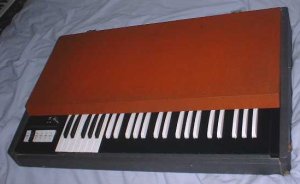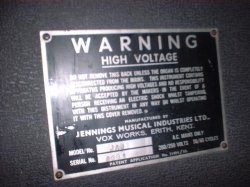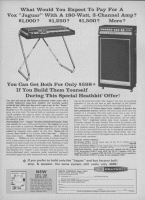
Vox: Jaguar/Corinthian
The Jaguar was the "budget-priced" model, for those who couldn't afford the Continental. Introduced around 1966, Jaguars were exclusively Italian-built - no Jaguar was ever made in the UK (of course, here I'm overlooking the Heathkit model, which might have been "built" anywhere in the world). It was a much simpler design, but was capable of some very good sounds, including some that sounded reminiscent of the Continental itself. The Jaguar was built into the same case as the Continental, and could easily be mistaken for one from a distance, especially from behind. Here's a characterization of the Jaguar's sound, as provided by Kirk Slinkard:
There were three main Jaguar variations:
Model V304: Dished rocker tabs, no Contour control, Same Continental top with gold "VOX" nameplate on the right. Produced around 1966-1967, and manufactured by GEM. According to Tersino Ilari, the relationship between JMI and GEM preceded the EME consortium
Model V304/E2: Flat rocker tabs, Contour control, black "Vox Jaguar" nameplate. Most Jaguars are of this type Produced around 1967 and later. These were manufactured by EME, which is probably what the "E" stands for. On some of these, the paper id tag on the inside says the model number is V304E. Also, on many of the metal ID badges, it looks like the "E2" part has been pasted on.
Heathkit: These were marketed by Heathkit, makers of numerous "built-it-yourself" electronic equipment kits. The Heathkit Jaguars are pretty much indistinguishable from the V304/E2 models, except for the word "Heathkit" added to the front and back logo plates.
The first model, V304, was made by GEM, who were also responsible for the Howard and the Doric. Internally, a V304 Jaguar is nearly identical in many ways to the Howard and the Doric - the oscillator cards, power supply and keyboard mechanism are all pretty much the same. The Jaguar differs in that it has less voice tabs, and lacks the coupler feature, but makes up for it by using pre-mixed footage combinations, for a fuller sound from a single set of key contacts. The second Jaguar model, the V304/E2, was made by EME. EME was busy making Continentals. and their production capacity was unable to handle the demand for the Jaguar. The EME models seem to be much more prevalent, however, so they must have ramped up production, pretty quickly, eventually producing the larger share of the two models. At this time, I don't have any historical information on the Heathkit model. It seems clear, however, that they must have gotten the parts from EME/Thomas and marketed it as a kit.
Controls:
Knobs: Contour, Bass Volume
Tabs: Vibrato Off/On, Bass Chords Off/On, Flute, Bright, Brass, Mellow.
The Bass Chords tab adds the organ voices to the bass section, which is monophonic, with low-note priority, so you could play a chord with at least one key in the bass section, and the lowest note depressed would sound a bass note as well.
As mentioned before, the keyboard has only a single set of contacts (only one contact per key). Without a coupler (as found on the Howard and the Doric), this usually means a very thin sound, with effectively only 8' voices. In the Jaguar, however, each key contact is fed a mixture of 2 or more footages, providing a much richer sound. Here are how they're broken down (thanks to Kirk for digging this out of the schematics):
C4 - C5: 16', 8'
(highest octave)
C3 - B3: 16', 8', 4'
C2 - B2: 16', 8', 4', 2'
C1 - B1: 8', 4', 2' (Bass Chords are on)
C1 - B1: 16'
(Bass Chords off - mono bass only)
1970 list price on the Jaguar was $399
1968 Heathkit price - $299-$349.
 |
| Ad from a 1967 issue of Beat Instrumental, depicting the GEM-made Jaguar. 125 Guineas in 1967 was about $312. |
  |
And here's an original owners manual for the earlier, V304 model. (Manual scans courtesy of Dave Wesson) |
Early "UK" Jaguar?
 |
A UK Jaguar?
There have been reports of Jaguars that are UK-made, as evidenced
by the nameplate, but these are just mis-labeled.
Knowledgeable Vox owner, Henry Badowski, reports that while the
nameplate on this Jaguar indicates a UK origin, he's certain that the organ is 100% Italian. The one shown here has a
model designation of "JAG". As stated on the "History"
page, the Italian manufacturers were supplied with JMI badges, and probably just used
them as needed.
Note that this one has no gold "VOX" logo on the right, nor are there any holes to indicate that one was ever there. It does have two holes in the top, presumably to hold a music rack. Note that the rear panel (shown below) is different from most other Jaguars. Otherwise, it looks just like other V304 models. |

Model "JAG". This plate is from the organ pictured above |

Rear panel from the one pictured above |

Another "UK" Jaguar plate - no model name specified. |
V304
This is a more typical example of the earlier model, produced by GEM. Below, you can see a comparison of the generator boards with those in a GEM Model-P, showing that they're pretty much identical. I believe these were made in 1966-67, but I've yet to see or hear about a date anywhere on one.
Serial number range seen: 204-0030 through 204-1665
Transition Models
I've seen several examples of what appear to be a sort of "Transition" model. These are basically a V304/E2 (black "Vox Jaguar" nameplate over keyboard, flat rocker tabs, contour controls), but with some characteristics from the V304 models:
the same ID badge used on the V304 models (Says "MFD. BY THOMAS ORGAN CO.", rather than "MANUFACTURED IN ITALY FOR THOMAS ORGAN CO."), with the pre-printed serial number prefix of "204". Most seem to have an "E2" pasted next to the "V304". In some, the stamped out part of the serial includes a "1" that seems to have been intended to over-strike the pre-printed "0" in "204" (to make it a "214" serial, as used in the V304E/2's). On others, the "204" on the internal paper tag has had a "1" hand-written over the "0", again, to change it to a "214" serial. I've also seen one or two examples of these that were also covered in the same textured type vinyl as the V304's (rather than the "chain mail" type used on the V304/E2's). Manufacture dates on these tend to be mid-1967.
Serial number range seen: 214-0122 through 214-0910.
Date range seen: 6/1/67 through 8/21/67
All of these are from Jaguars that are otherwise of the latter variety (Contour knob, flat tabs, black metal name strip across the front). The one on the right is a bit unusual, saying "Manufactured in Italy..." rather than "MFD. BY...", and the "E2" does not seem to be pasted on, but it does have a pre-printed serial number prefix of "204".
V304/E2
The later, EME-produced Jaguar: This model seems to be much more common.
Serial number range seen: 214-2307 through 214-5379.
Date range seen: 11/27/67 through 5/1/68
(Thanks to "G-force" for the zebra background pictures)
|
Complete leg case with pedal and manual - a rare find! |
Flat-top tabs, Contour control |
Typical ID badge |

Typical rear panel |
Note the two different lettering styles. I've not been able to correlate either of these with any other model characteristics. The version on the right seems to be much less common.
Heathkit - model TO-68
The Heathkit version seems identical to the V304E/2, and was probably just that - in kit form. I have no reliable serial number or date information on them - they do not seem to have been bestowed with date or serial number tags of any sort.

Looks just like a V304/E2 |

Rear nameplate |

Heathkit ad from 1968. A Jaguar AND a pretty nice looking amp for $700! Only $600 if you build it yourself (I think I'd spend the extra $100) |
Here's a Heathkit Jag story shared by website visitor Pat M:
"I ordered and built a HEATHKIT/VOX JAGUAR organ in 1968-69.($299.00) I remember it had 13 tone boards( All solid state) and a power supply (110-120VAC). I spent the better part of two months making thousands ( it seems) of solder connections. Much to my initial disappointment, the first time it was powered up, there was no sound. Fortunately, a trip to the local electronics expert (an electrician who refurbished full sized theatre organs) found the problem, a simple $1.00 diode in the power supply received too much heat from the solder gun in the process of installation. The organ worked well enough, with no major problems. Heathkit required that you install a dab of a putty like substance around the return springs on each key in the keyboard, why I never fully understood, except possibly it negated the initial excessive spring tension and excessive rebound of the keys to the performer. There were some matching problems; signal strength from the output of the treble side of the organ. A Bogen (or equal) preamp was used to solve this dilemma."
Corinthian
I've got no idea why they'd take a great organ like the Jaguar, with such a well-known and respected name, make some extraordinarily minor changes, and re-issue it as the "Corinthian". The name "Jaguar" brings to mind such things as speed, power and sleekness. "Corinthian" make me think of....a 1st century church with some big problems....or.....Ricardo Montalban ("...hand tooled Corinthian Leather..."). Great name, guys - way to go. No wonder they sold so many.
Controls:
Knobs: Contour, Bass Volume
Tabs: Vibrato Off/On, Bass Chords Off/On, Flute, Bright, Brass, Mellow.
The tone generator boards are of a different style, using resistor packs to replace several components with one.
The vinyl covering is of the "chain mail" type used on the (later) EME V304/E2 Jaguars.
(Thanks to Nigel for the pictures)